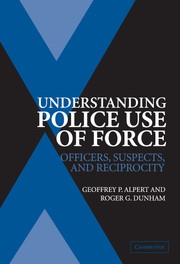Book contents
- Frontmatter
- Contents
- Acknowledgments
- Introduction: The Context of Police Use of Force
- 1 Police Use of Force: The History of Research
- 2 The Crucial Element: Finding Research Sites
- 3 Findings from Miami-Dade Police Department Study
- 4 The Sequential Steps in Use-of-Force Incidents in the Miami-Dade Police Department
- 5 Miami-Dade Police Department: Inconsistencies between Officer and Suspect Accounts of the Use of Force
- 6 Findings from Prince George's County Police Department
- 7 Findings and Summary
- 8 Explaining Police Use of Force: The Breakdown of an Authority Maintenance Ritual
- Appendix: Frequencies of Force Sequences for First through Tenth Actions
- Index
- References
Introduction: The Context of Police Use of Force
Published online by Cambridge University Press: 14 July 2009
- Frontmatter
- Contents
- Acknowledgments
- Introduction: The Context of Police Use of Force
- 1 Police Use of Force: The History of Research
- 2 The Crucial Element: Finding Research Sites
- 3 Findings from Miami-Dade Police Department Study
- 4 The Sequential Steps in Use-of-Force Incidents in the Miami-Dade Police Department
- 5 Miami-Dade Police Department: Inconsistencies between Officer and Suspect Accounts of the Use of Force
- 6 Findings from Prince George's County Police Department
- 7 Findings and Summary
- 8 Explaining Police Use of Force: The Breakdown of an Authority Maintenance Ritual
- Appendix: Frequencies of Force Sequences for First through Tenth Actions
- Index
- References
Summary
we live in a world that increasingly displays distaste for the use of physical force to direct or control the behavior of others. Democracy as a form of governmental decision making is winning out over totalitarianism, and war is less tolerated as a solution to conflict. On a nongovernmental level, there are severe penalties for fighting and bullying in schools and spanking is increasingly viewed as inappropriate parenting. Similarly, the movement to end violence against intimates is growing ever stronger with increasingly severe penalties for spouse abuse. There is one profession in Western society, however, that has not only retained the right to use physical force against its citizens, but has its members trained and encouraged to do so. The police are prepared to use force on a daily basis and while there may be considerable pressure to limit and restrict the use of force by the police against citizens, no one is calling for them to abandon its use. Indeed, it would be unconscionable to make such a demand.
Despite the fact that the police represent the last bastion of civilian government-sanctioned violence against citizens, research on police use of force is surprisingly scarce. David Bayley (1994) drew attention to the discrepancy between the significance of the police role in modern society and the amount of attention given to it by researchers.
- Type
- Chapter
- Information
- Understanding Police Use of ForceOfficers, Suspects, and Reciprocity, pp. 1 - 16Publisher: Cambridge University PressPrint publication year: 2004

